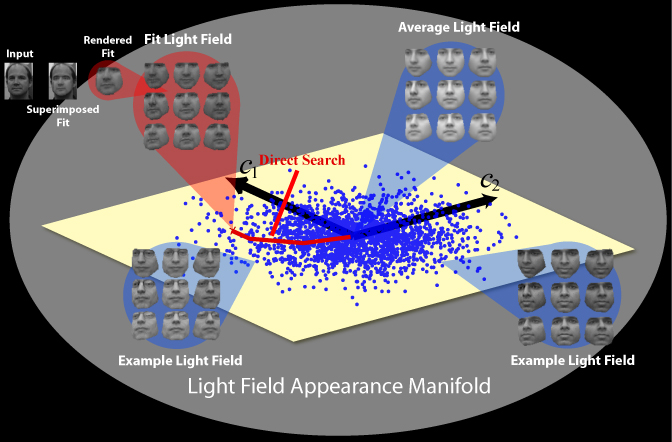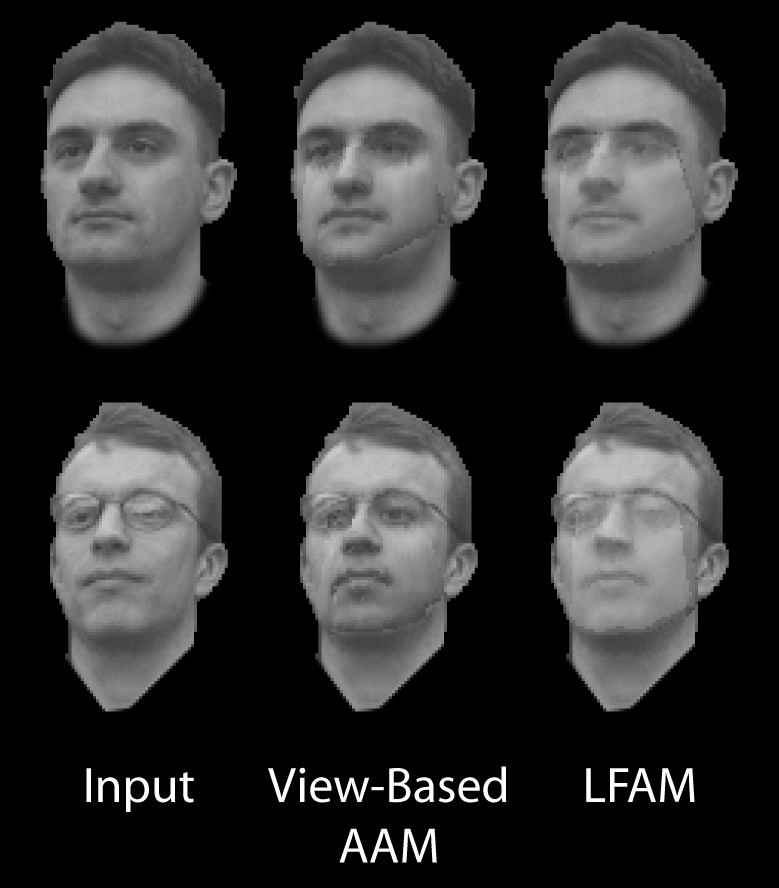 |
|
|
|
|
Light-Field Appearance Manifolds
| |
| Principal
Investigators: |
|
|
| Abstract: |
| Statistical
shape and texture appearance models are powerful image representations, but
previously had been restricted to 2D or 3D shapes with smooth surfaces and Lambertian
reflectance. In this work we present a novel 3D appearance model using image-based
rendering techniques, which can represent complex lighting conditions, structures,
and surfaces. We construct a light field manifold capturing the multi-view appearance
of an object class and extend the direct search algorithm of Cootes and Taylor
to match new light fields or 2D images of an object to a point on this manifold.
When matching to a 2D image the reconstructed light field can be used to render
unseen views of the object. Our technique differs from previous view-based active
appearance models in that model coefficients between views are explicitly linked,
and that we do not model any pose variation within the shape model at a single
view. It overcomes the limitations of polygonal based appearance models and
uses light fields that are acquired in real-time.. |
|
| Light
Field Appearance Manifolds: |
| A light
field [3,5] is a structured set of images that capture a static object
or scene from a range of viewing directions. A new view of the object is synthesized
from the light field using light field rendering, an efficient image-based rendering
algorithm that does not require knowledge of scene geometry. Light fields can
model the appearance of objects with non-Lambertian surface reflectance and
complex geometry. A light field appearance manifold is defined by the
set of light fields of an object class and is a surface in the space of light
fields. In this work we present a method for representing light field appearance
manifolds using Principle Component Analysis (PCA). More generally, we develop
a shape-and-texture appearance model [1,4] parameterized over light fields of
objects. A light field appearance manifold of the human face, modelled using
our algorithm, is displayed below. Light field appearance models define a powerful
technique for representing the appearance of objects with complex surface reflectance
and geometry. |
| |
 |
| Figure
1. |
Light
field appearance manifold of the human face. Provided an image of a previously
unseen object with unknown pose, our algorithm matches the object to a point
on the manifold that best approximates the object's appearance in the input
view. A full light field of the object is recovered.
|
|
| |
| Model Matching and Evaluation: |
| Provided
an image of a previously unseen object with unknown pose, we would like to match
the object to a point on the appearance manifold that best approximates the
object's appearance in the input view. With our algorithm, the object's pose
is estimated and example light fields are combined to recover a full light field
of the input object. Synthetic light fields, generated from the light field
appearance manifold of Figure 1 are displayed by Figure 2. In the figure, select
views of the 6 x 8 light fields are shown. Note our method is able to infer
48 views of the human face provided a single view. |
| |
 |
| Figure
2. |
Matching a light field appearance model to 2D images of novel subjects
with unknown pose. The reconstructed light field, is rendered over the input
view and is displayed aside each match. The light field appearance model generates
convincing light field reconstructions from 2D images. In particular, the overall
shape and texture of each subject are well approximated across each view.
|
|
| |
We compare
our algorithm to a competing approach in Figure 3. The View-based Active Appearance
Model [2] defines a piecewise linear representation of the multi-view appearance
of an object. It is defined by fitting local Active Appearance Models (AAMs)
over regions of pose space. Since the View-based AAM blends several poses at
a single model, it is difficult to represent objects with non-Lambertian surface
reflectance and complex geometry with this approach. This point is illustrated
by Figure 3. The View-based AAM is unable to represent the specular reflection
in the subject's glasses and is adversely affected by the interpose occlusion
of the glasses. The light field appearance model can faithfully represent the
appearance of the subject's glasses. |
| |
 |
| Figure
3. |
Comparison of a light field appearance model to a View-based AAM. The
left column shows the input, the middle column the best fit with a 2D AAM, and
the right column the light field fit. The View-based AAM and light field appearance
models both exhibit qualitatively good fits when the surface is approximately
smooth and lambertian.When glasses are present, however, the 2D method fails
and the light field appearance model succeeds.
|
|
| |
| Publication: |
| |
| C.
Mario Christoudias, Louis-Philippe Morency, Trevor
Darrell, Light Field Appearance Manifolds, Proceedings
of the European Conference on Computer Vision, 2004. |
| |
| References: |
T. F. Cootes, G. J. Edwards, and C. J. Taylor, “Active appearance models,” Lecture
Notes in Computer Science, vol. 1407, pp. 484–98, 1998.
-
T. F. Cootes, G. V. Wheeler, K. N. Walker, and C. J. Taylor, “View-based active appearance
models,” Image and Vision Computing, vol. 20, pp. 657–664, 2002.
-
S. J. Gortler, R. Grzeszczuk, R. Szeliski, and M. F. Cohen, “The lumigraph,” Computer
Graphics, vol. 30, no. Annual Conference Series, pp. 43–54, 1996.
-
M. J. Jones and T. Poggio, “Multidimensional morphable models,” in ICCV, 1998,
pp. 683–688.
-
M. Levoy and P. Hanrahan, “Light field rendering,” Computer Graphics, vol.
30, pp. 31–42, 1996.
|
|
|
|
|
|
 |